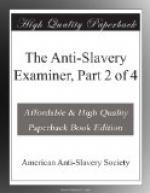Although these evils still exist, yet, since the abolition of slavery, there is one symptom of returning purity, the sense of shame. Concubinage is becoming disreputable. The colored females are growing in self-respect, and are beginning to seek regular connections with colored men. They begin to feel (to use the language of one of them) that the light is come, and that they can no longer have the apology of ignorance to plead for their sin. It is the prevailing impression among whites, colored, and blacks, that open licentiousness cannot long survive slavery.
Prejudice was another of the concomitants of slavery. Barbadoes was proverbial for it. As far as was practicable, the colored people were excluded from all business connections; though merchants were compelled to make clerks of them for want of better, that is, whiter, ones. Colored merchants of wealth were shut out of the merchants’ exchange, though possessed of untarnished integrity, while white men were admitted as subscribers without regard to character. It was not a little remarkable that the rooms occupied as the merchants’ exchange were rented from a colored gentleman, or more properly, a negro;[A] who, though himself a merchant of extensive business at home and abroad, and occupying the floor below with a store, was not suffered to set his foot within them. This merchant, it will be remembered, is educating a son for a learned profession at the university of Edinburgh. Colored gentlemen were not allowed to become members of literary associations, nor subscribers to the town libraries. Social intercourse was utterly interdicted. To visit the houses of such men as we have already mentioned in a previous chapter, and especially to sit down at their tables, would have been a loss of caste; although the gentry were at the same time living with colored concubines. But most of all did this wicked prejudice delight to display itself in the churches. Originally, we believe, the despised color was confined to the galleries, afterwards it was admitted to the seats under the galleries, and ultimately it was allowed to extend to the body pews below the cross aisle. If perchance one of the proscribed class should ignorantly stray beyond these precincts, and take a seat above




